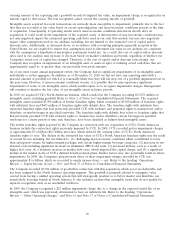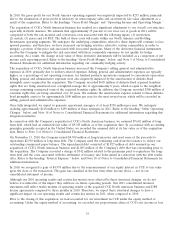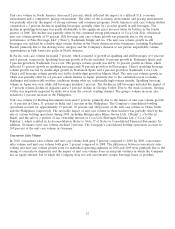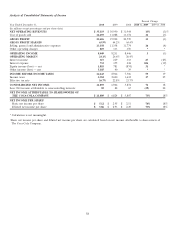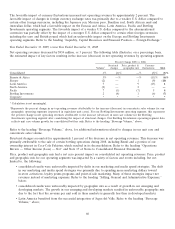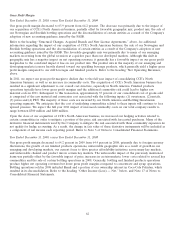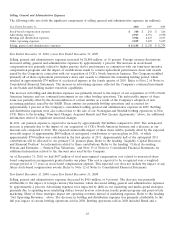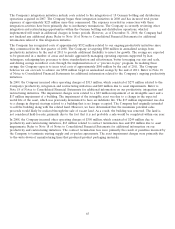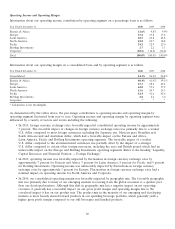Coca Cola 2010 Annual Report Download - page 58
Download and view the complete annual report
Please find page 58 of the 2010 Coca Cola annual report below. You can navigate through the pages in the report by either clicking on the pages listed below, or by using the keyword search tool below to find specific information within the annual report.growth in 2010. The group’s strong marketing initiatives, including our FIFA World Cup activation programs,
contributed to the unit case volume growth in North America.
The volume and net operating revenues attributable to the sale of DPS brands have been included as a structural
change in our analysis of net operating revenues. Refer to the heading ‘‘Net Operating Revenues,’’ below, and
‘‘Structural Changes and New License Agreements,’’ above.
In Pacific, unit case volume increased 6 percent, which consisted of 13 percent growth in still beverages and 2 percent
growth in sparkling beverages. The group’s volume growth was led by 6 percent growth in China, 15 percent growth in
the Philippines and 3 percent growth in Japan. China’s volume growth included 21 percent growth in juices and juice
drinks primarily due to the continued strong momentum of Minute Maid Pulpy, as well as strong growth in other still
beverages including water. Tough weather conditions, including flooding in the higher per capita consumption regions,
negatively impacted unit case volume in China. In the Philippines, unit case volume growth was led by 14 percent
growth in Trademark Coca-Cola. In Japan, the unit case volume growth was driven by successful in-market activations,
strong innovation and favorable weather conditions. Included in Japan’s unit case volume growth was 5 percent growth
in Trademark Coca-Cola, primarily due to strong FIFA World Cup activation programs and our Coca-Cola Summer
Promotion. Japan’s unit case volume growth also benefited from 17 percent growth in sports drinks.
Unit case volume for Bottling Investments decreased 1 percent, primarily due to the deconsolidation of certain entities
as a result of the Company’s adoption of new accounting guidance issued by the FASB. These entities are primarily
bottling operations and have been accounted for under the equity method of accounting since they were deconsolidated
on January 1, 2010. Refer to the heading ‘‘Critical Accounting Policies and Estimates — Principles of Consolidation’’
and ‘‘Structural Changes, Acquired Brands and New License Agreements.’’ The deconsolidation of these entities
negatively impacted the unit case volume for Bottling Investments by approximately 9 percent. Unit case volume for
Bottling Investments was also negatively impacted by the sale of our Norwegian and Swedish bottling operations to New
CCE. The unfavorable impact of the aforementioned items was partially offset by growth in markets where we own or
otherwise consolidate the bottling operations. Unit case volume grew 6 percent in China, 17 percent in India,
15 percent in the Philippines and 1 percent in Germany. The Company’s consolidated bottling operations account for
approximately 33 percent, 66 percent, 100 percent and 100 percent of the unit case volume in China, India, the
Philippines and Germany, respectively.
Year Ended December 31, 2009, versus Year Ended December 31, 2008
In Eurasia and Africa, unit case volume increased 4 percent, which consisted of 3 percent growth in sparkling beverages
and 8 percent growth in still beverages. The group’s unit case volume growth was primarily attributable to 31 percent
growth in India, led by 32 percent growth in sparkling beverages. The sparkling beverages growth in India was largely
due to double-digit growth in Trademarks Thums Up, Sprite, Fanta and Coca-Cola. Still beverages in India grew
28 percent, driven by double-digit growth in Trademark Maaza. The group also benefited from 6 percent volume growth
in North and West Africa and 10 percent volume growth in East and Central Africa. The group’s unit case volume
growth also included the impact of a 14 percent volume decline in Russia, primarily due to a challenging economic
environment. In addition, South Africa and Turkey each experienced a 1 percent unit case volume decline.
Unit case volume in Europe decreased 1 percent, primarily attributable to difficult macroeconomic conditions
throughout most of Europe. These difficult macroeconomic conditions impacted a number of key markets and
contributed to unit case volume declines of 8 percent in South and Eastern Europe, 4 percent in Iberia and 2 percent
in Germany. The volume declines in these markets were partially offset by 6 percent unit case volume growth in France
and 4 percent growth in Great Britain. The unit case volume growth in both France and Great Britain was led by
Trademark Coca-Cola.
In Latin America, unit case volume increased 6 percent, which consisted of 3 percent growth in sparkling beverages and
24 percent growth in still beverages. The group benefited from strong volume growth in key markets, including
6 percent in Mexico, 4 percent in Brazil, 2 percent in Argentina and double-digit growth in Colombia. Acquisitions
contributed 1 percentage point of the group’s total unit case volume growth. The group’s sparkling beverage volume
growth was primarily attributable to 4 percent growth in brand Coca-Cola. The successful integration of Jugos del
Valle, S.A.B. de C.V. (‘‘Jugos del Valle’’) drove still beverage volume growth.
56


